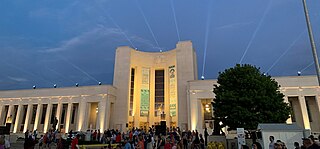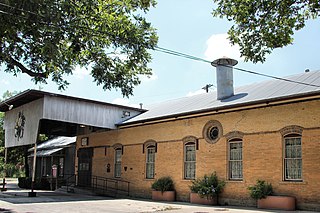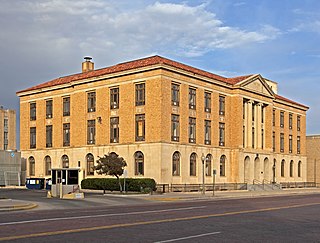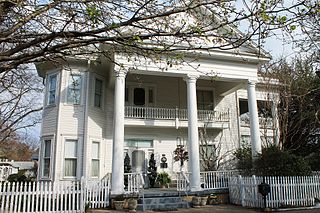
Wheatley Place is a neighborhood in South Dallas, Texas, that is designated as a historic district on the National Register of Historic Places (NRHP) and as a somewhat smaller Dallas Landmark District by the city. Included among the buildings that compose the historic district is the Juanita J. Craft Civil Rights House, a museum that was the former home of Dallas civil rights pioneer, Juanita Craft. The house is a Recorded Texas Historic Landmark and is included within the NRHP district but not the municipal landmark district.

The Hall of State is a building in Dallas's Fair Park that commemorates the history of the U.S. state of Texas and is considered one of the best examples of Art Deco architecture in the state. It was designed and built for the Texas Centennial Exposition.

Lubbock High School is a 5A high school serving grades nine to twelve in Lubbock, Texas, as part of the Lubbock Independent School District,

Fort Duncan was a United States Army base, set up to protect the first U.S. settlement on the Rio Grande near the current town of Eagle Pass, Texas.

The Dewitt C. Greer State Highway Building is an eight-story structure in downtown Austin, Texas housing offices of the Texas Department of Transportation since its completion. Located at the southwest corner of 11th and Brazos Streets, the building was designed by San Antonio architect Carleton Adams and finished in 1933 at a cost of $455,000. It features elaborate Art Deco styling, including decorative carved limestone panels above the front doors. The building was added to the National Register of Historic Places along with the 1918 State Office Building in 1998.

The Texas Technological College Dairy Barn, located on the Texas Tech University campus in Lubbock, Texas, was constructed from 1926–27 and served as a teaching facility for 40 years. The building was designed by architect W. C. Hedrick of Fort Worth, Texas, with assistance from Agricultural Dean A. H. Leidigh and Professor W. L. Stangel.

The Warren and Myrta Bacon House, 1802 Broadway, Lubbock, Texas, United States, was designed and built from plans by W. M. Rice of Amarillo, Texas, in 1916. It was designed along neo-classical lines for Warren A. Bacon, a successful local businessman and civic leader. The house was placed on the National Register of Historic Places in 1982.

Texarkana Union Station is a historic train station in the Texarkana metropolitan area serving Amtrak, the United States' national passenger rail system. The Arkansas-Texas border bisects the structure; the eastern part, including the waiting room and ticket office, are in Texarkana, Arkansas, but the western part is in Texarkana, Texas, meaning stopped trains span both states. The station was built in 1928 and was added to the U.S. National Register of Historic Places in 1978. Today it is the second busiest Amtrak station in Arkansas.

The Cactus Theater is a theater in Lubbock, Texas. It hosts live music productions, musicals, and theatrical plays.

The Texas Technological College Historic District is a historic district listed on the National Register of Historic Places on the campus of Texas Tech University in Lubbock, Texas. The 110-acre (0.45 km2) district is made up of 27 contributing properties, four non-contributing properties, one contributing structure, one contributing object, and one contributing site.

The Kress Building at 1109 Broadway in Lubbock, Texas was built in 1932 as a S. H. Kress & Co. store building. It was listed on the National Register of Historic Places in 1992.

List of NRHP-registered historic places in Lubbock County, Texas

Farmers Union Gin Company was an American cotton processing company located in San Marcos, Texas. Its main facility, located at 120 Grove Street, is now a registered historic site.

Meusebach Creek School is located at 515 Kuhlmann Road in Gillespie County, in the U.S. state of Texas. It was consolidated with Fredericksburg Independent School District in 1954. The school is currently being used as a community center and was added to the National Register of Historic Places listings in Gillespie County, Texas on May 10, 2005.

This is a list of the National Register of Historic Places listings in Garza County, Texas.

Cotton Belt Railroad Industrial Historic District is located in the eastern part of Grapevine, Texas.

The Lubbock Post Office and Federal Building, located at 800 Broadway in downtown Lubbock, Texas, was a post office and federal courthouse from 1932 to 1968.

The Marcus DeWitt Carlock House is a house with Neoclassical and late-Victorian architectural characteristics that is listed on the National Register of Historic Places and as a Recorded Texas Historic Landmark located at 407 South Main Street, approximately three blocks south of downtown, in Winnsboro, Wood County, Texas. It was the first National Register of Historic Places listing in the city of Winnsboro.























